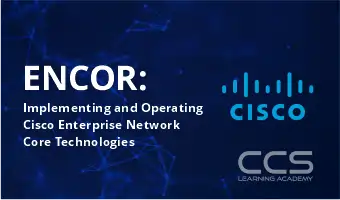ENCOR: Implementing and Operating Cisco Enterprise Network Core Technologies
* Looking for a flexible schedule (after hours or weekends)? Please call 858-208-4141 or email us: sales@ccslearningacademy.com.
Student financing options are available.
Transitioning military and Veterans, please contact us to sign up for a free consultation on training and hiring options.
Looking for group training? Contact Us
About This Course
Course Description:
The Implementing and Operating Cisco Enterprise Network Core Technologies (ENCOR) is a 5-day course that gives you the knowledge and skills needed to configure, troubleshoot, and manage enterprise wired and wireless networks. You’ll also learn to implement security principles within an enterprise network and how to overlay network design by using solutions such as SD-Access and SD-WAN.
This course will help you:
-
- Configure, troubleshoot, and manage enterprise wired and wireless networks
-
- Implement security principles within an enterprise network
-
- Prepare you to take the 350-401 Implementing Cisco Enterprise Network Core Technologies (ENCOR) exam
To earn CCNP Enterprise, you pass two exams: a core exam(ENCOR) and an enterprise concentration exam of your choice. And every exam in the CCNP Enterprise program earns an individual Specialist certification, so you get recognized for your accomplishments along the way.
The core exam focuses on your knowledge of enterprise infrastructure including dual-stack (IPv4 and IPv6) architecture, virtualization, infrastructure, network assurance, security, and automation. The core exam is also the qualifying exam for CCIE Enterprise Infrastructure and CCIE Enterprise Wireless certifications. Passing this exam helps toward earning any or all of these certifications.
Concentration exams focus on emerging and industry-specific topics such as network design, SD-WAN, wireless, and automation. You can prepare for concentration exams by taking corresponding Cisco training courses.
Concentration exams (choose one)
Learning Objectives
Inclusions
- Certified Instructor-led training
- Official Training Seminar Student Handbook
- Collaboration with classmates (not currently available for self-paced course)
- Real-world learning activities and scenarios
- Exam scheduling support*
- Enjoy job placement assistance for the first 12 months after course completion.
- This course is eligible for CCS Learning Academy’s Learn and Earn Program: get a tuition fee refund of up to 50% if you are placed in a job through CCS Global Tech’s Placement Division*
- Government and Private pricing available.*
- *For more details call: 858-208-4141 or email: training@ccslearningacademy.com; sales@ccslearningacademy.com
Pre-requisites
- The knowledge and skills that a learner should have before attending this course are as follows:
- Implementation of Enterprise LAN networks
- Basic understanding of Enterprise routing and wireless connectivity
- Basic understanding of Python scripting
- The following Cisco courses can help you gain the knowledge you need to prepare for this course:
- Implementing and Administering Cisco Solutions v1.0
- Introduction to Cisco Programmability
Target Audience
- Mid-level network engineers
- Network administrators
- Network support technicians
- Help desk technicians







